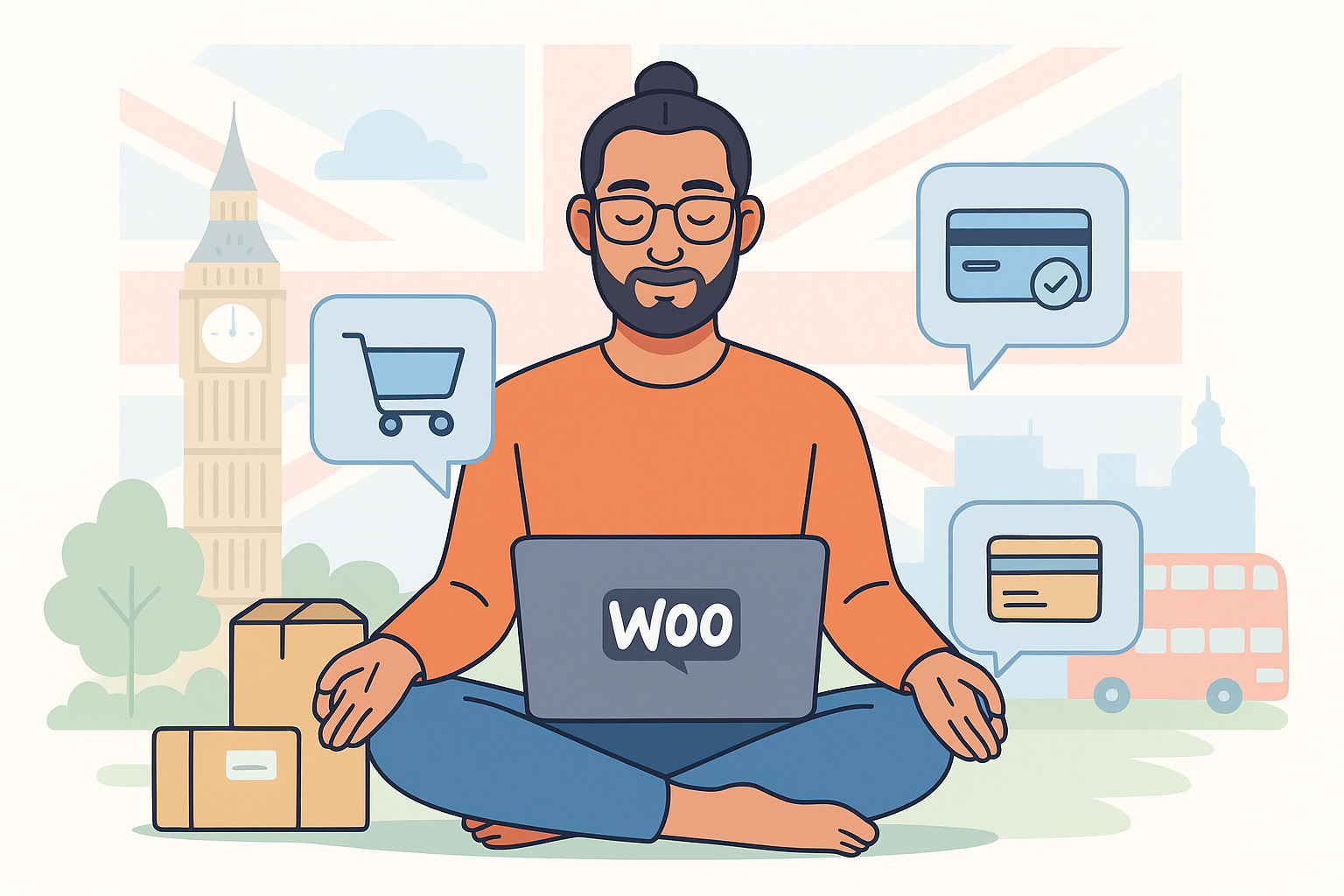So, you’ve decided to launch an online store in the UK. Brilliant choice!
Whether you’re selling handmade candles from your cosy kitchen, eco-friendly dog accessories, or the next big fitness product, WooCommerce makes it surprisingly easy to turn your WordPress website into a fully functioning e-commerce shop.
But here’s the catch — while WooCommerce itself is free and beginner-friendly, setting up your store the right way (so it’s legal, secure, and optimised for sales) takes a bit of insider know-how.
In this guide, we’ll walk through everything you need to know to set up your WooCommerce store in the UK — from hosting and payments to shipping and compliance. And yes, we’ll keep it friendly, jargon-light, and sprinkled with real-world tips.
Table of Contents
Why Choose WooCommerce for Your UK Store
There are plenty of e-commerce platforms out there — Shopify, Wix, Squarespace — so why does WooCommerce stand out for UK businesses?
It’s Free (Mostly) – The core plugin is completely free to use. You’ll only pay for hosting, premium themes, or optional extensions.
Full Control – You own your store data entirely, unlike some SaaS platforms.
Customisable – There’s a plugin for almost every feature imaginable.
Great for SEO – Since it’s built on WordPress, SEO customisation is easy.
Supports UK-Specific Features – UK VAT rates, Royal Mail shipping integrations, GBP currency.
💡 Pro Tip: If you want professional help in setting up your store, WebJourny offers expert WooCommerce setup services tailored for UK businesses.
Step 1: Secure Your Domain & Hosting
Your domain name is your online address, and your hosting is where your store lives.
Domain: Choose a
.co.ukor.ukdomain for local trust.Hosting: Look for a UK-based hosting provider or one with UK servers for faster loading times.
Recommended Hosting Features for WooCommerce:
SSL certificate included (mandatory for UK e-commerce)
PHP 8.0+ and MySQL 5.7+
Staging environment for testing
24/7 support
Step 2: Install WordPress & WooCommerce
Most hosting providers offer a 1-click WordPress install. Once WordPress is live:
Go to Plugins → Add New.
Search for WooCommerce.
Install and Activate.
You’ll be greeted by the WooCommerce Setup Wizard, which will guide you through basic configuration like currency (GBP), store location, and shipping zones.
Step 3: Configure WooCommerce Settings
Head to WooCommerce → Settings and work through:
General: Store address, currency, selling locations.
Products: Units (grams/kg), reviews, inventory settings.
Tax: Enable taxes, set VAT rates for UK and EU customers.
Shipping: Zones, rates, and methods.
Payments: Enable Stripe, PayPal, or bank transfers.
Accounts & Privacy: GDPR-compliant settings.
Emails: Customise order confirmation and shipping notifications.
Step 4: Add Products
Navigate to Products → Add New.
Product Title: Clear and keyword-rich.
Description: Use persuasive copy and bullet points.
Images: High-quality, well-lit, and consistent size.
Price: Inclusive of VAT if applicable.
Categories/Tags: Help customers (and search engines) navigate your store.
💡 If you want a ready-made WooCommerce template with all settings optimised, check our packages.
Step 5: Set Up Payment Gateways
Popular UK WooCommerce payment options include:
Stripe – Accept credit/debit cards and Apple Pay.
PayPal – Trusted globally.
Klarna – “Buy Now, Pay Later” option.
Direct Bank Transfer – For B2B or high-value orders.
Always ensure your payment gateways are PCI compliant.
Step 6: Configure UK Shipping Options
For UK deliveries, WooCommerce supports:
Flat Rate Shipping – Fixed cost per order.
Free Shipping – Great for orders over a certain amount.
Royal Mail Integration – Real-time rates.
Click & Collect – For local customers.
💡 You can integrate Royal Mail or DPD plugins for accurate live rates.
Step 7: Ensure UK Legal Compliance
Running an online store in the UK comes with legal responsibilities:
GDPR Compliance – Clear privacy policy, cookie consent.
Consumer Contracts Regulations – 14-day return policy.
VAT Rules – Register for VAT if you meet the threshold (£90,000 turnover in 2025).
Terms & Conditions – Clear and accessible.
Age-Restricted Products – Age verification if applicable.
Step 8: Optimise for SEO & Performance
To attract customers, your store needs to rank well in search engines.
Install Yoast SEO or Rank Math.
Use descriptive product titles and meta descriptions.
Optimise images (WebP format recommended).
Enable caching and a CDN.
💡 For ongoing SEO and website care, check our services.
Step 9: Test Before Launch
Before going live:
Place a test order using different payment methods.
Check mobile responsiveness.
Test all email notifications.
Verify speed using GTmetrix or PageSpeed Insights.
Step 10: Launch & Promote Your Store
Once everything works perfectly:
Announce on social media.
Email your mailing list.
Consider Google Ads or Meta Ads for instant traffic.
Start blogging to build organic traffic — read more on our blog.
FAQs
Q1: Do I need a business licence to sell online in the UK?
A: Not necessarily for most products, but you must register as self-employed or set up a company with HMRC.
Q2: Can I sell internationally with a UK WooCommerce store?
A: Yes, WooCommerce supports multiple currencies, shipping zones, and tax rates.
Q3: How long does it take to set up a WooCommerce store?
A: A basic store can be set up in a day, but full optimisation may take a week or more.
Q4: Is WooCommerce better than Shopify for UK sellers?
A: WooCommerce offers more control and lower ongoing costs, but Shopify is easier for beginners.
Q5: What’s the average cost of running a WooCommerce store in the UK?
A: Expect hosting (£10–£25/month), domain (£8–£12/year), and optional plugins/themes (£50–£300/year).
Final Thoughts
Setting up a WooCommerce store in the UK isn’t just about installing a plugin — it’s about creating a secure, legally compliant, and customer-friendly shopping experience. By following the steps above, you’ll have a store ready to impress customers and drive sales.
And if you’d rather skip the technical hassle, you can always get in touch with WebJourny’s experts to set everything up for you — while you focus on your products and customers.

